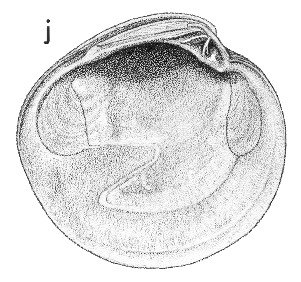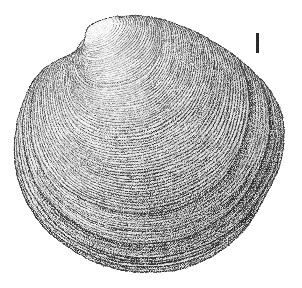
Revised descriptions of New Zealand Cenozoic Mollusca from Beu and Maxwell (1990)

 | Revised descriptions of New Zealand Cenozoic Mollusca from Beu and Maxwell (1990) | 
|
  (Pl. 46j): holotype of D. wanganuiensis Marwick, Castlecliff, Wanganui (Shakespeare Cliff Sand?), Castlecliffian (TM4685, GNS) |
  (Pl. 46l): holotype of D. wanganuiensis Marwick, Castlecliff, Wanganui (Shakespeare Cliff Sand?), Castlecliffian (TM4685, GNS) |
Beu & Maxwell (1990): Chapter 16; p. 344; pl. 46 j, l.
Synonymy: Arthemis subrosea Gray 1835, p. 309; Dosinia (Phacosoma) wanganuiensis Marwick 1927, p. 586; D. (Austrodosinia) subrosea
Classification: Veneridae: Dosiniinae
Description: Moderately large for genus (45-63 mm long), almost circular, weakly inflated, thick and solid, with smooth margins. Umbo strongly anterior; dorsal margin only weakly curved, producing a weak postero-dorsal wing; remainder of margin regularly curved. External sculpture of about 20 low, wide, closely spaced commarginal ridges per cm, weakly anastomosing and narrower over posterior wing than elsewhere; lunule small, wide, deeply impressed, steeply angled. Hinge of right valve with long narrow posterior cardinal tooth separated widely from the closely spaced, wide, triangular, median cardinal and narrow anterior cardinal teeth, and with a short anterior lateral socket with raised edges; hinge of left valve with long, low, very thin posterior cardinal tooth, thick, bevelled median cardinal tooth, widely separated high, thin anterior cardinal tooth, and low, wide, anterior lateral knob. Adductor scars narrow, weakly impressed; pallial sinus deep, V-shaped, apex at centre of shell length, directed at centre of anterior adductor scar.
Comparison: We agree with Powell (1979, p. 423) that Dosinia wanganuiensis is identical to D. subrosea; Marwick evidently had not seen large modern specimens of D. subrosea. Unnamed Waipipian to Nukumaruan species of D. (Phacosoma) from Wanganui basin and Hawke's Bay differ from D. subrosea in their thinner shells and finer sculpture. The subgenus appears to have arrived in New Zealand (presumably from the tropical Pacific) during Opoitian or Waipipian time. D. subrosea is readily recognised by its relatively small size (compared with D. anus), its fine, even, flat-topped commarginal ridges, and its moderately prominent postero-dorsal "wing". The larger species D. (Austrodosinia) anus (Nukumaruan-Recent) has much coarser sculpture, lamellose on the posterior wing, and is an obligate open-ocean sand beach species.
Distribution: Waipipian-Recent; Recent, New Zealand (type of Arthemis subrosea); Castlecliff, Wanganui (the preservation and yellow-brown colour suggest a Shakespeare Cliff Sand provenance), Castlecliffian (type of Dosinia wanganuiensis). D. subrosea lives commonly at low tide off sand beaches, both in enclosed bays and on open coasts, and so is a common fossil in a variety of soft-bottom facies.
Cite this publication as: "A.G. Beu and J.I. Raine (2009). Revised
descriptions of New Zealand Cenozoic Mollusca from Beu and Maxwell (1990). GNS
Science miscellaneous series no. 27."
© GNS Science, 2009
ISBN
978-0-478-19705-1
ISSN 1177-2441
(Included with a PDF facsimile file
copy of New Zealand Geological Survey Paleontological Bulletin 58 in CD version
from: Publications Officer, GNS Science, P.O. Box 30368 Lower Hutt, New
Zealand)